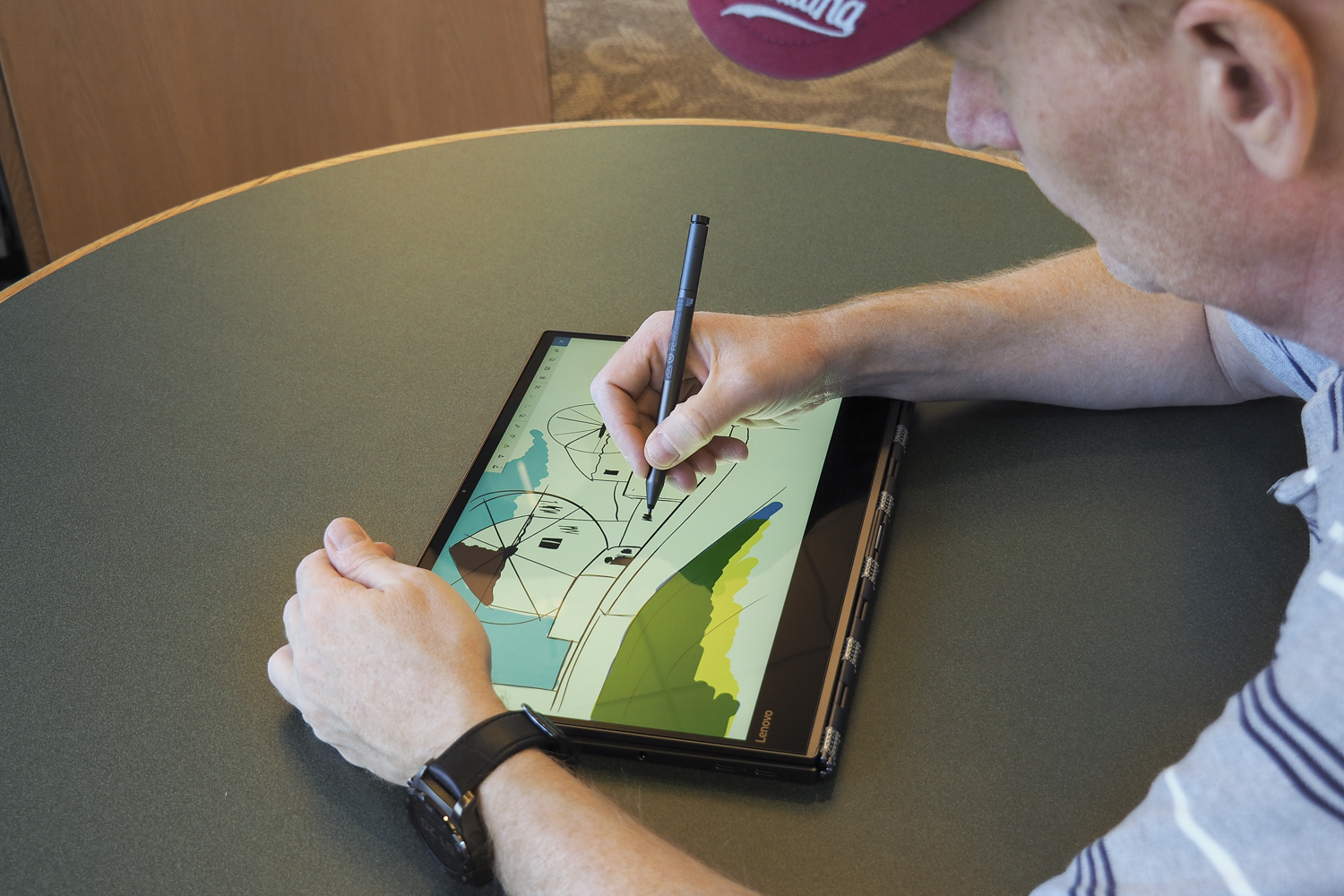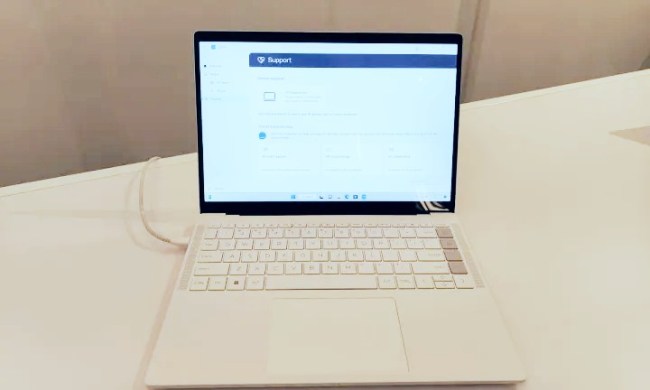Sitting right above the 13.3-inch convertible 2-in-1 are a few 14-inch machines that provide slightly larger displays without adding too much to chassis size. Lenovo’s Yoga 920 is a classic example, and one of the most robustly built. Asus has just introduced another option, the ZenBook Flip 14, that enjoys the distinction of building in a bone fide discrete GPU.
The Lenovo Yoga line has long been one of our favorite among the premium brands, and the Yoga 920 represents refined version. We pit the Asus ZenBook Flip 14 vs. the Lenovo Yoga 920 to see if discrete graphics is enough to win over one of the best around.
|
Asus ZenBook Flip 14 |
Lenovo Yoga 920 |
|
| Dimensions | 12.89 x 8.92 x 0.55 in | 12.7 x 8.8 x 0.50 in |
| Weight | 3.31 pounds | 3.02 pounds |
| Keyboard | Full-size backlit keyboard | Full-size backlit keyboard |
| Processor | Up to eighth-generation Intel Core i7 | Up to eighth-generation Intel Core i7 |
| RAM | 8GB or 16GB RAM | 8GB or 16GB |
| Graphics | Intel UHD 620
Nvidia GeForce MX150 |
Intel UHD 620 |
| Display | 14-inch IPS display | 13.9-inch IPS display |
| Resolution | Full HD (1,920 x 1,080 or 157 PPI) | Full HD (1,920 x 1,080 or 158 PPI) |
| Storage | Up to 512GB PCIe SSD | Up to 1TB PCIe SSD |
| Networking | 802.11ac, Bluetooth 4.1 | 802.11ac, Bluetooth 4.1 |
| Connectivity | USB-A 3.0 (x2), USB-C 3.1, HDMI, microSD card reader, 3.5mm combo jack | USB-A 3.0, USB-C with Thunderbolt 3, 3.5mm combo jack |
| Windows Hello | Fingerprint scanner | Fingerprint scanner |
| Operating System | Windows 10 | Windows 10 |
| Battery | 57 watt-hour | 70 watt-hour |
| Price | $900 | $1,330+ |
| Availability | Now | |
| Review | 3.5 out of 5 stars | 4.5 out of 5 stars |
Design
The ZenBook Flip 14 shares the same basic aesthetic as the rest of the ZenBook line, with the iconic Asus concentric circle design adorning the lid, and a Slate Gray color scheme that’s rather conservative. It does little to stand out in a crowd. In terms of build quality, we found it to offered a mostly rigid chassis that’s just the slightest bit flexible in the lid and keyboard deck. The rather stiff hinge required two hands to open, but kept the display firmly in place.
The Lenovo Yoga 920 was refreshed late in 2017, and it adopted the same basic Yoga look with some subtle changes. There are some additional angles providing a slightly cleaner overall appearance, and three color schemes (Platinum, Bronze, and Copper) are available. The Yoga 920 is relatively thin (0.50 inches compared to the ZenBook’s 0.55 inches) and light (3.02 pounds versus 3.31 pounds), with smaller display bezels for a smaller chassis overall. Most significantly, the Yoga 920 is built like a tank, with not a single surface bending under pressure, and the hinge both looks more modern. It’s smooth and effective while moving through the usual 2-in-1 modes.
Of all the notebooks we’ve reviewed lately that have shaved off some girth, the Yoga 920 has managed to hold onto its impressively solid build. While it’s also somewhat conservative, it’s a much more attractive machine than the ZenBook Flip 14.
Winner: Lenovo Yoga 920
Performance
Both the Zenbook Flip 14 and the Yoga 920 sport Intel’s latest and greatest mobile CPUs, the powerful and efficient eighth-generation Intel Core series. Our review units were equipped with the Intel Core i7-8550U, a chip that packs in four cores, doubling the previous generation. The CPU manages clock speeds to provide awesome performance when needed, and great efficiency when battery life is paramount.
While Asus and Lenovo both squeeze out good performance from the CPUs, the Yoga 920 was just slightly faster in terms of its processor performance. But the ZenBook Flip 14 has a trick up its sleave — it incorporates a discrete GPU, the low-end Nvidia GeForce MX150. This isn’t a hardcore gaming GPU but rather one that’s suited for older titles and eSports gaming, but it’s significantly faster than the usual integrated Intel graphics inside the Yoga 920.
If you want to do some light gaming on your convertible 2-in-1, or to encode some video, then you’ll appreciate the ZenBook Flip 14’s mobile graphics performance.
Winner: Asus ZenBook Flip 14
Keyboard, Mouse, and Pen
In our review, we weren’t terribly impressed by the ZenBook Flip 14’s keyboard, finding that while it offered decent key travel, the bottoming action is much too abrupt and makes typing less comfortable and precise. The touchpad was good, however, with Microsoft Precision touchpad support and a large surface area — although some of it is taken up by the Windows Hello-supporting fingerprint scanner. Asus includes its active pen with the ZenBook, but the machine’s display is oddly sticky and makes inking an imprecise affair.
The Yoga 920’s keyboard is of typical Lenovo quality, on the other hand. While we found the keys a bit stiff, the good travel and distinct tactile feedback made for a precise typing experience. The Microsoft Precision touchpad was less responsive than we like, though, with some issues using gestures. The Lenovo active pen was another standout, offering four times the pressure sensitivity (4,096 versus 1,024), and with a display that provides a more suitable surface, and thus a significantly better inking experience. The Yoga 920 also uses a fingerprint scanner for Windows Hello support.
Although the ZenBook Flip 14’s touchpad was better, the Yoga 920’s keyboard and pen are vast improvements. They combined to give Lenovo the win in this round.
Winner: Lenovo Yoga 920
Connectivity
Asus focused mostly on providing legacy connectivity support on the ZenBook Flip 14, with two USB-A 3.0 ports and a full-size HDMI port to go with the single USB-C 3.1 port. That’s in addition to the microSD card slot, 2×2 MU-MIMO Wi-Fi, and Bluetooth. Most notably, Asus did not equip its 2-in-1 with Thunderbolt 3, which limits display support and negates the option of an external GPU enclosure.
Lenovo, on the other hand, looked to both the past and the present with the Yoga 920, equipping a USB-A 3.0 port to go with two Thunderbolt 3-supporting USB-C ports. There’s also an SD card reader and the usual Wi-Fi and Bluetooth connectivity.
The Yoga 920 might not have a discrete GPU, but its Thunderbolt 3 support means you can plug in an external GPU enclosure for even faster gaming than the ZenBook Flip 14 as long as you’re sitting still. That gives Lenovo another win.
Winner: Lenovo Yoga 920
Display
We found the ZenBook Flip 14’s 14-inch Full HD (1,920 x 1,080 or 157 PPI) display to be slightly less than average for the premium 2-in-1 class. Brightness was particularly low, and contrast and color gamut were all at the low end of the range. It was a decent enough experience subjectively, as are even average premium displays today, but its objective qualities leave something to be desired.
The Yoga 920’s 13.9-inch Full HD (158 PPI) display was quite a bit better. First, brightness was much higher, exceeding the 300 nit baseline we like to see, and its contrast and color support were superior. Perhaps most important, Lenovo also offers a 4K UHD (3,840 x 2,160 or 317 PPI) option for the Yoga 920, something that Asus is not offering for the ZenBook.
Not only is the Yoga 920’s entry-level display better, but you can step up to a much sharper 4K option as well. That’s a real win for Lenovo.
Winner: Lenovo Yoga 920
Portability and Battery Life
Intel’s eighth-generation CPUs are very efficient when they’re working on the typical productivity task. They’ll use more battery if you doing more intensive tasks like encoding video, but Office work, web browsing, and watching movies will barely move the battery meter.
In our testing, the Yoga 920 and ZenBook Flip 14 both burned the battery at close to the same clip when performing more CPU intensive tasks, coming within a few minutes of each other running our intensive Basemark test and looping through a series of web pages. The Yoga 920, however, last almost four hours longer when playing a local video, meaning that its going to last much longer when you’re consuming media.
Both 2-in-1s will likely get you through most of a day’s work without needing to plug in, but you can’t ignore the Yoga 920’s power-sipping ways when watching movies and TV shows.
Winner: Lenovo Yoga 920
Availability and Price
Both the Yoga 920 and the ZenBook Flip 14 can be equipped with configurations that lie firmly in the premium notebook space. Our review ZenBook was built with a Core i7-8550U, 16GB of RAM, and a 512GB SSD for a retail price of $1,300. This compares to $1,600 for a similarly equipped Yoga 920. You can also pick up a budget configuration of the ZenBook for $900, with a Core i5-8250U, 8GB of
We have to give some kudos to Lenovo for offering a 4K display option, which adds $200 to the price, along with the option of a 1TB SSD that Asus omits. But the ZenBook Flip 14 is clearly the more frugal machine, and in fact its budget option is a great alternative for anyone looking to save some money.
Winner: Asus ZenBook Flip 14
The Yoga 920 is a more refined machine
The ZenBook Flip 14 is a two-trick pony in this particular comparison. It has faster graphics allowing for some entry-level gaming, and it’s less expensive. Those are good qualities to have.
The Yoga 920, however, is a more refined convertible 2-in-1, with class-leading build quality, a conservative yet modern aesthetic, and better processor performance and battery life. If you really want to run Rocket League while on the road, then the ZenBook Flip 14 is a good option. For everyone else, the Yoga 920’s overall design wins out — and if you insist on gaming, then put a real GPU into an enclosure and plug it into the Thunderbolt 3 port. That’s something the ZenBook just can’t support.






